Printable primary worksheets
All of our resources come complete with answer sheets to save time for busy teachers and parents. Input your child’s scores and keep track of your child's progress.
worksheet plans from £3.20/monthAll of our resources come complete with answer sheets to save time for busy teachers and parents. Input your child’s scores and keep track of your child's progress.
worksheet plans from £3.20/month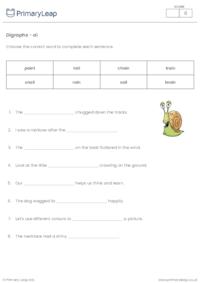
Digraphs: ai cloze activity This handy worksheet will help young learners practice reading while reinforcing their understanding of words with the "ai" sound. There are eight fill-in-the-blank sentences for children to complete including these words: paint, tail, chain, train, snail, rain, sail, and brain.
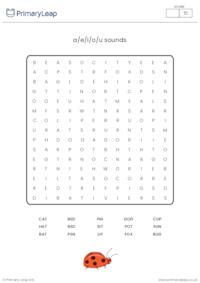
Spelling word search - Short vowel soundsThis engaging activity focuses on words containing the vowel sounds: A, E, I, O, and U. The grid is filled with a variety of words that highlight these specific sounds. This word search can be used as a supplementary tool during phonics/spelling lessons or as a fun activity to assess students' vowel sound knowledge. Encourage students to search for words horizontally and vertically within the grid.
 Free
Free
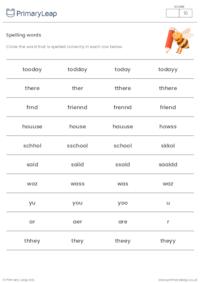
Circle the word that is spelled correctlyCircling the correct spelling of a word can greatly benefit young learners in their spelling development. This activity allows them to visually compare different spelling options and choose the correct one in each row. Choosing the correct spelling promotes attention to detail and encourages children to pay close attention to individual letter formations. It also provides a structured and focused way for students to practice spelling independently.
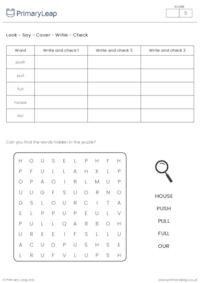
How will this worksheet help my child?Word searches are an enjoyable activity for children. The interactive nature of searching for words in a puzzle format makes spelling practice more engaging and exciting for young learners. There are 5 words hidden in the puzzle for children to find. This activity can be used in the classroom or at home.
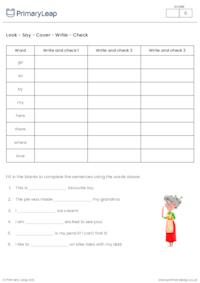
Year 1 spelling worksheetThis handy year 1 worksheet promotes vocabulary development, sentence construction, and comprehension skills. There are six fill in the blanks sentences for children to complete using the correct words from the spelling list.
 Free
Free
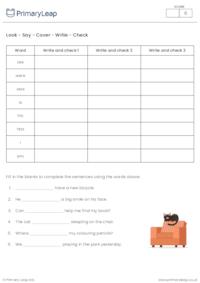
Year 1 spelling activityBy filling in the blanks with the appropriate word, students reinforce their understanding of subject pronouns, verb tenses, and possessive pronouns. This exercise helps develop sentence construction skills and language comprehension. This year 1 spelling worksheet can be used in the classroom or at home.
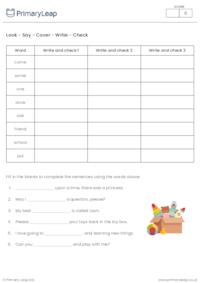
Year 1 spelling activityThese sentences allow students to practice using words like "come," "some," "one," "once," "ask," "friend," "school," and "put" in meaningful contexts. The exercise promotes vocabulary development, sentence structure, and comprehension skills. Students 'Look, Say, Cover, Write and Check' each spelling word by completing the table.
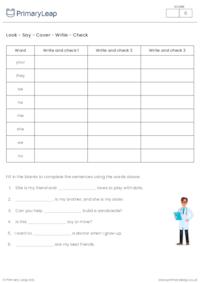
How will this resource help my child?These sentences provide opportunities for students to practise using possessive pronouns ("your," "they," "he," "me," "she," and "we") and the negation word "no." By filling in the blanks with the appropriate word, students reinforce their understanding of pronouns, express ownership, and learn to form sentences in a meaningful context.
 Free
Free
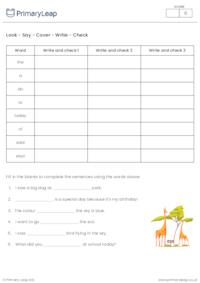
Year 1 Spelling PracticeThis handy English activity involves fill-in-the-blank sentences for 5-6-year-old students. It aims to reinforce their understanding and usage of common words such as "the," "a," "do," "to," "today," "of," "said," and "says." The exercise can be used by educators to promote language skills, including vocabulary, grammar, and sentence construction.
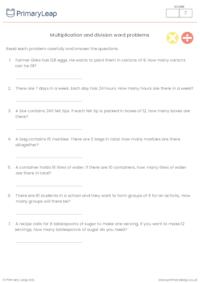
Multiplication and division word problemsThis KS2 maths resource will help students to solve multiplication and division word problems. Students read each question carefully, identify the operations involved, and perform the calculations step by step. There are seven problems for students to solve.
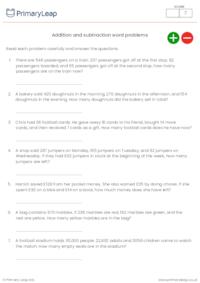
Addition and subtraction word problemsThis KS2 maths resource will help students to solve addition and subtraction multi-step problems. Students read each question carefully, identify the operations involved, and perform the calculations step by step. There are seven problems for students to solve.
 Free
Free
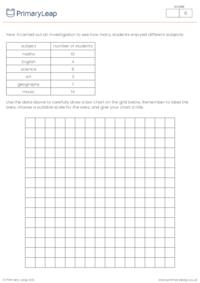
Bar charts - Presenting dataYear 4 Statistics:interpret and present discrete and continuous data using appropriate graphical methods, including bar charts and time graphs.This year 4 maths worksheet is a handy resource for children to use to learn how to read and present data in their own bar chart.
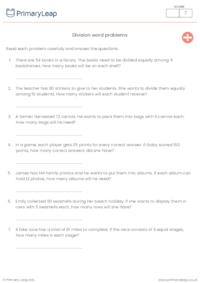
Division word problemsThis handy division worksheet is perfect for getting your KS2 students practising their division skills to solve simple word problems. Solving division word problems requires critical thinking and problem-solving skills. There are 7 word problems for children to read through. The resource also comes complete with answers for quick marking.
 Free
Free
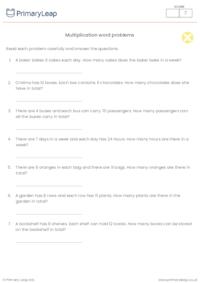
Multiplication word problemsBy solving multiplication problems, students develop a concrete understanding of how multiplication represents repeated addition or grouping. This handy maths resource has 7 multiplication problems for students to solve.
 Free
Free
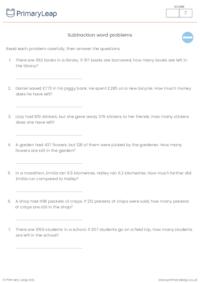
Subtraction word problemsBy engaging with subtraction word problems, students will learn to think critically, make informed decisions, and solve problems effectively. This maths worksheet for KS2 students includes 7 problems to solve.
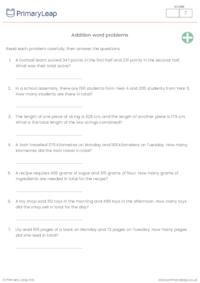
How will this worksheet help my child?Addition word problems help students develop problem-solving abilities, critical thinking, and mathematical reasoning. These skills are vital for their academic success and will help them solve problems encountered in everyday life.
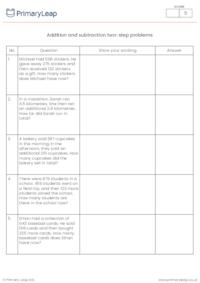
Addition and subtraction two-step problemsTo solve these word problems, students will need to perform two steps involving addition and subtraction. Carefully read the problem, identify the relevant information, and perform the operations in the correct order. There are 5 questions for children to answer. There is also space for students to show their workings.
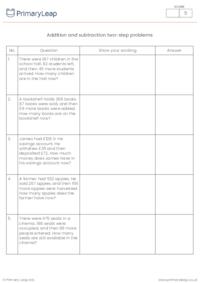
Addition and subtraction two-step problemsTo solve these word problems, students will need to perform two steps involving addition and subtraction. Carefully read the problem, identify the relevant information, and perform the operations in the correct order. There are 5 questions for children to answer. There is also space for students to show their workings.
 Free
Free
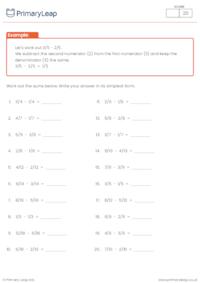
Subtracting fractionsLet's work out 3/5 - 2/5. We subtract the second numerator (2) from the first numerator (3) and keep the denominator (5) the same.3/5 - 2/5 = 1/5 Students solve each of these subtraction problems by subtracting the second numerator from the first numerator and keeping the denominator the same.
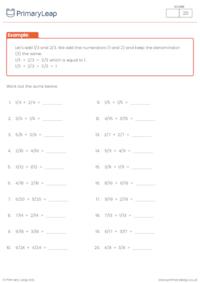
Adding fractions activityTo add fractions with the same denominator, you simply add the numerators together and keep the common denominator unchanged. Let's add 1/3 and 2/3. We add the numerators (1 and 2) and keep the denominator (3) the same.1/3 + 2/3 = 3/3 which is equal to 1. 1/3 + 2/3 = 3/3 = 1 Students work out the sums and write the answer in its simplest form.
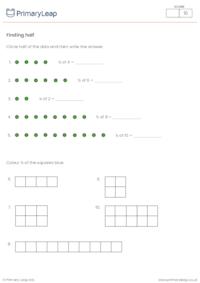
Finding halfOffer regular opportunities for students to practice finding halves of objects through a variety of activities and worksheets. Use this handy worksheet to help support KS1 students as they develop their understanding of fractions. Children are asked to circle half of the objects and then colour half of the squares. This will help them visually understand the concept of half.
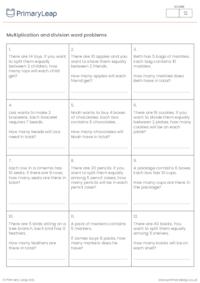
Multiplication and division word problemsWith this handy multiplication and division maths worksheet, students will practise their 2, 5 and 10 times tables. There are 12 problems where children will need to practise their multiplication and division skills. Word problems help students develop critical thinking and problem-solving skills as they figure out which operation (multiplication or division) is appropriate to solve the given problem.
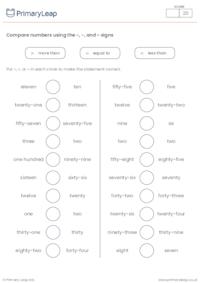
Year 2 Maths - Number and Place ValueThis handy maths resource will help students compare numbers in words from 0 up to 100 using <, >, and = signs. Students put the correct comparison symbol in the circles to complete the 20 mathematical statements. This worksheet will also help children recognise and read numbers written in words.
 Free
Free
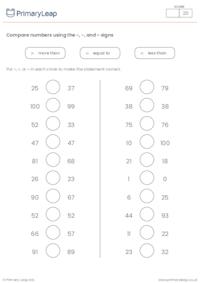
Year 2 Maths - Number and Place ValueThis handy maths resource will help students compare numbers from 0 up to 100 using <, >, and = signs. Students put the correct comparison symbol in the circles to complete the 20 mathematical statements.
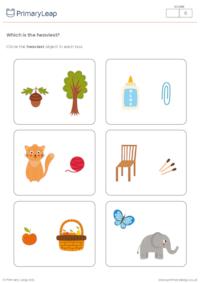
Year 1 Measurement - Mass/weightStudents are asked to circle the heaviest object in each group.
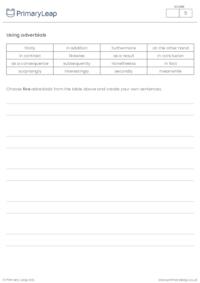
Using adverbialsAdverbials can be used to provide sequencing, introduce additional information, show contrast, indicate cause and effect, summarise, and add emphasis to students' writing. Students read through the table of adverbials and choose five to include in sentences of their own.
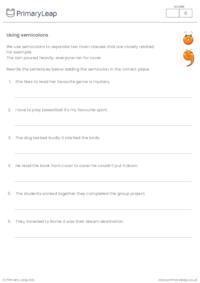
Using semicolonsThe semicolon is used to separate two closely related independent clauses that could stand as separate sentences. Students rewrite the sentences adding the semicolon in the correct place.
 Free
Free
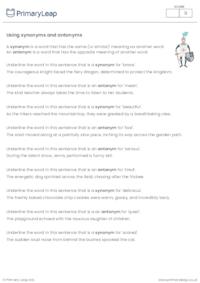
Using synonyms and antonymsA synonym is a word that has the same (or similar) meaning as another word. An antonym is a word that has the opposite meaning of another word. Using synonyms and antonyms helps students to communicate more effectively, improves their reading comprehension, and develops their critical thinking skills. This handy KS2 worksheet will help children recognise and use synonyms and antonyms correctly.
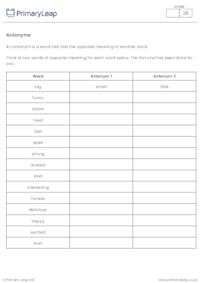
Antonyms worksheetHelp your students enhance their vocabulary and add variety to their writing and speaking with this handy antonyms worksheet. Encouraging the use of antonyms can foster a deeper understanding of word meanings and help students communicate their ideas more effectively. Children think of two words of opposite meanings for each word in the table. The first one has been done for them.
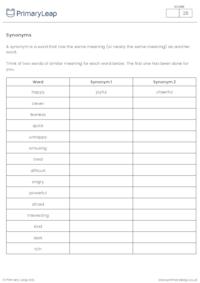
Synonyms worksheetHelp your students enhance their vocabulary and add variety to their writing and speaking with this handy synonyms worksheet. Encouraging the use of synonyms can foster a deeper understanding of word meanings and help students communicate their ideas more effectively. Children think of two words of similar meaning for each word in the table. The first one has been done for them.
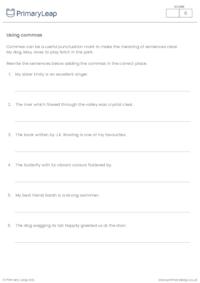
Using commasCommas can be a useful punctuation mark to make the meaning of sentences clear. My dog, Max, loves to play fetch in the park. Students rewrite the sentences adding the commas in the correct place.
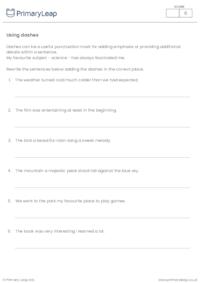
Using dashesDashes can be a useful punctuation mark for adding emphasis or providing additional details within a sentence. My favourite subject – science – has always fascinated me. Students rewrite the sentences adding the dashes in the correct place. This worksheet can be used in the classroom or at home and includes an answer sheet for quick marking.
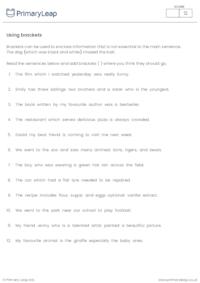
Using bracketsBrackets are used to enclose information that is not essential to the main sentence. The information inside the brackets can provide additional details or clarification. Students are asked to add brackets where they think they should go in each sentence. An answer is included for quick marking. This KS2 grammar activity can be used in the classroom or at home and is a great introduction to using brackets in writing.
 Free
Free
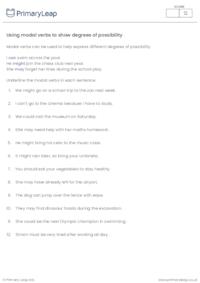
Using modal verbs to show degrees of possibilityModal verbs can be used to express different degrees of certainty or likelihood in a statement. Modal verbs of possibility include: definitely, certainly, surely, maybe, clearly, obviously, perhaps, probably and undoubtedly. With this upper KS2 literacy activity, students are asked to underline the adverbs of possibility in each sentence.
 Free
Free
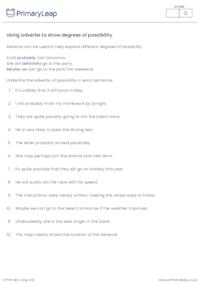
Using adverbs to show degrees of possibilityAdverbs can be used to express different degrees of certainty or likelihood in a statement. Adverbs of possibility include: definitely, certainly, surely, maybe, clearly, obviously, perhaps, probably and undoubtedly. With this upper KS2 literacy activity, students are asked to underline the adverbs of possibility in each sentence.
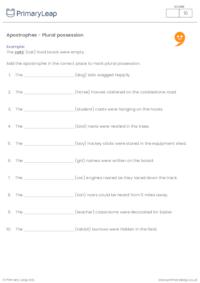
Apostrophes - Plural possessionStudents add the apostrophe in the correct place to mark plural possession. An example is shown to help students complete the activity.
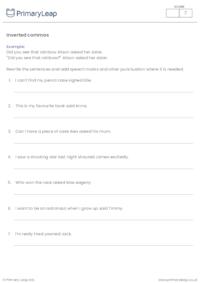
Adding inverted commas to a sentenceWith this handy worksheet, students will practise adding inverted commas and other punctuation to sentences. Remember, when using inverted commas for direct speech, the punctuation goes inside the closing inverted comma.
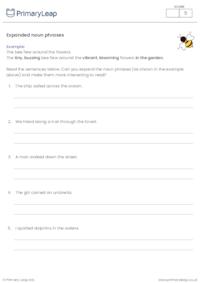
Expanded noun phrasesExpanded noun phrases add more detail to the overall meaning of the sentence. For example:The bee flew around the flowers. The tiny, buzzing bee flew around the vibrant, blooming flowers in the garden.Students have a go at improving the sentences by expanding the noun phrases, making them more interesting to read.
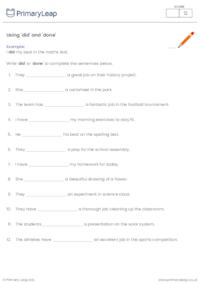
Using 'did' and 'done' correctlyLearning to use 'did' and 'done' correctly enhances communication skills and helps children become more confident with their writing. This handy English worksheet for lower KS2 asks students to complete the sentences by writing 'did' or 'done'. They must decide whether 'did ' or 'done' is the appropriate verb by writing the correct one in the spaces. "Did" is used for all subjects (I, you, he, she, it, we, they). "Done" is used with helping verbs (e.g., have, has, had) or as an adjective.
 Free
Free
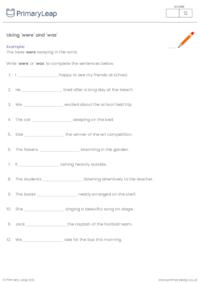
Using 'was' and 'were correctlyUsing "was" and "were" correctly helps convey information accurately and clearly. This handy English resource for lower KS2 asks students to complete the sentences by writing 'was' or 'were'. They must decide whether 'was ' or 'were' is the appropriate verb by writing the correct one in the spaces. "Was" is used for singular subjects (I, he, she, it), while "were" is used for plural subjects (they, we).
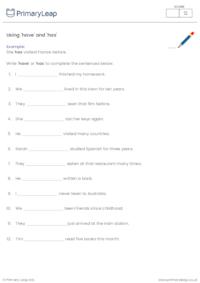
Using 'have' and 'has' activityWith this handy year 3 worksheet, students are asked to write 'have' or 'has' to complete the sentences. This activity can be used in the classroom or at home and comes complete with an answer sheet for quick marking. Students can also have a go at marking their own work.
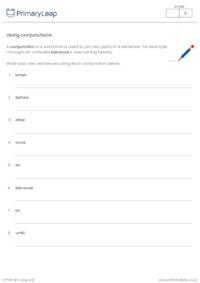
Conjunctions writing activityA conjunction is a word that is used to join two parts of a sentence. For example:I brought an umbrella because it was raining heavily.Students write their own sentences using each conjunction included on the worksheet. This resource is a great activity to help children learn how to use conjunctions correctly in their writing.
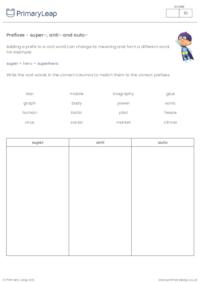
Prefixes - super–, anti– and auto–Adding a prefix to a root word can change its meaning and form a different word. For example:super + hero = superheroStudents write the root words in the correct columns to match them to the correct prefixes.
 Free
Free
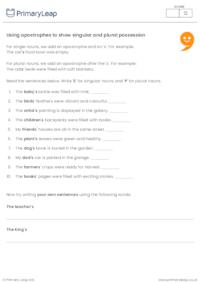
Using apostrophes to show singular and plural possessionFor single nouns, we add an apostrophe and an 's'. For example:The cat's food bowl was empty.For plural nouns, we add an apostrophe after the 's'. For example:The cats' beds were filled with soft blankets.
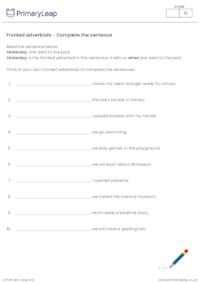
Fronted adverbials - Complete the sentence activityUsing fronted adverbials encourages students to start sentences in different ways, adding variety and interest to their writing. It also helps students understand and apply proper grammar and punctuation rules.With this worksheet, children are asked to think of their own fronted adverbials to complete the sentences. This resource can be used at home or in the classroom and is great practice for creative writing.
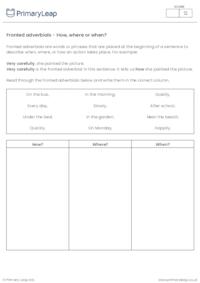
Fronted adverbials sorting activityFronted adverbials are words or phrases that are placed at the beginning of a sentence to describe when, where, or how an action takes place. For example:Very carefully, she painted the picture. Very carefully is the fronted adverbial in this sentence. It tells us how she painted the picture. We use fronted adverbials to add variety and detail to sentences. Students sort the fronted adverbials by writing them in the correct column.
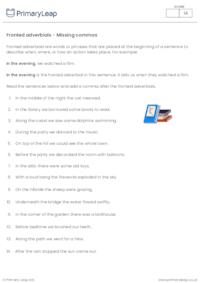
What are fronted adverbials?Fronted adverbials are words or phrases that are placed at the beginning of a sentence to describe when, where, or how an action takes place. For example:In the evening, we watched a film. In the evening is the fronted adverbial in this sentence. It tells us when they watched a film.Students read the sentences and add a comma after the fronted adverbials.
 Free
Free
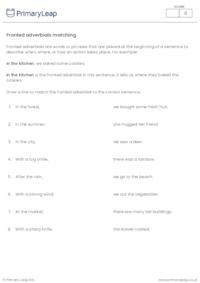
What are fronted adverbials?Fronted adverbials are words or phrases that are placed at the beginning of a sentence to describe when, where, or how an action takes place. For example: In the kitchen, we baked some cookies. In the kitchen is the fronted adverbial in this sentence. It tells us where they baked the cookies.Students draw a line to match the fronted adverbial to the correct sentence.




Check out our ready-to-use worksheets that can be used in the classroom or at home. Simply download or print and watch your child’s confidence grow with our easy to follow printables.


One of the best things about printable worksheets is that they make learning fun and easy. Explore our educational resources based on and keep your children learning through these fun and engaging exercises.


Our printable worksheets are designed for progressive learning. Our engaging content enables a child to learn at their own speed and gain confidence quickly. When we help a child believe in themselves, we empower them for life.


Printable worksheets are a great way to enhance creativity and improve a child’s knowledge. Help your child learn more about with this great selection of worksheets designed to help children succeed.
An email has been sent to your account please activate your account to continue.

PrimaryLeap has introduced a new interactive learning platform and would like to offer you a completely Free Upgrade.
We understand that you may only want to use our services for worksheets and may not want to upgrade your account.
But if you are interested in trying out our new services then you're just a click away.
An email has been sent to your account please activate your account to continue.
You've answered
and have 2 Questions remaining
Import multiple students information through a CSV File. Browse or drag .CSV file below.